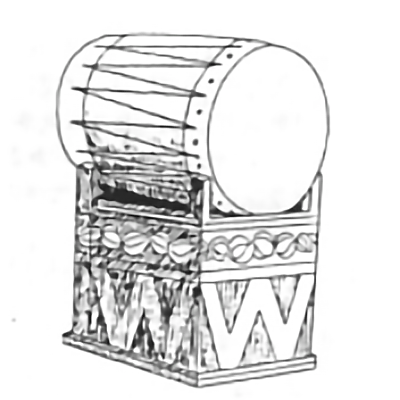guanglong overview
 Guangyuan (pinyin: Guāng lǒng) is also known as Guanglong. "Guangnong" means a big drum, and "Ga" means dance, that is, a big drum. The Dai nationality smashes the membrane sounding instrument. "Light" in Dai language means drum. "Zhou" or "Nong" are both big, meaning a big drum. Popular in Yunnan Province Xishuangbanna Dai Autonomous Prefecture, Dehong Dai and Jingpo Autonomous Prefecture, Menglian, Gengma and other places. The Baoshan Dai area in the lower reaches of the Nujiang River is called "Guangnong", and the Dai area in Xishuangbanna is called "Guangbian".
Guangyuan (pinyin: Guāng lǒng) is also known as Guanglong. "Guangnong" means a big drum, and "Ga" means dance, that is, a big drum. The Dai nationality smashes the membrane sounding instrument. "Light" in Dai language means drum. "Zhou" or "Nong" are both big, meaning a big drum. Popular in Yunnan Province Xishuangbanna Dai Autonomous Prefecture, Dehong Dai and Jingpo Autonomous Prefecture, Menglian, Gengma and other places. The Baoshan Dai area in the lower reaches of the Nujiang River is called "Guangnong", and the Dai area in Xishuangbanna is called "Guangbian".More than 500 years ago, the Dai people had such big drums. For hundreds of years, Guangyuan has been popular in Dai Township. Today, it is an inseparable accompaniment instrument for the traditional Dai folk dance "Gaguang Nong". "Guangnong" means a big drum, and "Ga" means dance, that is, a big drum. With a long history, Li Sicong of the Ming Dynasty wrote about the customs of the Dai people in the "Bai Yi Zhuan": "When they feast in the countryside, they beat drums, blow reeds, and dance (shield) boards for fun." According to this historical record, Guanghui It has a history of more than five hundred years. For a long time, it has been spread in the area of the Dai people who believe in Theravada Buddhism, and has been enshrined in Buddhist temples. The drum frame is made of hollowed out whole safflower tree, in the shape of a cylinder, and the drum surfaces at both ends are covered with untreated hairy raw cowhide. The size varies. It is placed on a wooden frame on the side of the front porch of the Manting Buddhist Temple in Jinghong County. The diameter of the drum surface is 81 cm, the height of the drum frame is 128 cm, and the periphery of the drum skin is fixed with thirty square wooden nails. The top is thick and the bottom is thin and square, and the wooden pegs that expose the outside of the drum frame are 5 cm long. The shape is somewhat similar to the Setu of the Jino tribe.
When playing, the light is placed on a wooden drum stand with a height of 100 cm. The sound is deep and heavy, with strong resonance, and it can be transmitted for miles. It is also possible to strike together with two people, one person in front of the dance while striking and dancing, and the other person in the back with two thin and long bamboo strips to accompany the percussion, making the sound of "dong, bang, bang". During the percussion, there are large, small and Dai cymbal ensembles, and the atmosphere is warm. In the past, on the first and fifteenth day of each month of the Dai calendar, the Buddhist temples used to play the lights, sing and dance. In addition, it is also used in ceremonies such as chanting Buddhist scriptures.
After the 1950s, the Song and Dance Troupe from Xishuangbanna Dai Autonomous Prefecture in Yunnan Province reintroduced the Guangluo and its songs and dances that had been played in Buddhist temples for a long time, and moved them to the artistic stage. The Xishuangbanna State Song and Dance Troupe is used for stage performances. It is small in size. The diameter of the drum surface is 50 cm, the height of the drum frame is 69 cm, the height of the drum frame is 100 cm and the width is 62 cm. The drum frame is painted with ethnic-style colorful patterns. . When performing alone, there is a small drum hanging on the lower right side of the light close-up, and the player beats the big and small drums alternately. The sound level is different, and the sound changes are rich. The light beams originally placed in Buddhist temples have also been used in festivals or festive occasions, and are usually used for singing and dancing accompaniment in grand festivals such as the Water Splashing Festival of the Dai people.
- Pinyin:Guāng lǒng
- alias:light
- category:slamming membrane musical instrument
- nationality:Dai people
overview of other similar instruments
- sanyanxiao overview
- Daguangxian overview
- Leiqin overview
- hahao overview
- yandundagu overview
- Han Xiaozheng overview
- Fang Xiang overview
- guanzi overview
- zhuqin (Dao Qin) overview
- zhuiqin overview
- bangzi overview
- three-stringed piano overview
- Gehu overview
- xiao overview
- xiaokonghou overview
- Konghou overview
- Sheng overview
- suona overview
- hulusi overview
- gushao overview
 渝公网安备 50010702504639号
渝公网安备 50010702504639号